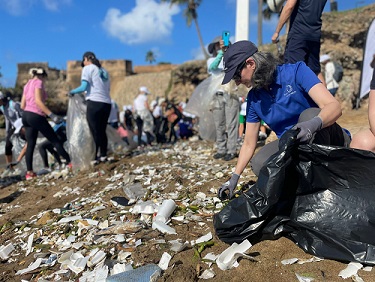The Ocean Conservancy’s new report reveals a plastic foam fiasco: plastic foam takeout containers – often colloquially referred to by the brand name “Styrofoam” – were the seventh most common item collected by International Coastal Cleanup volunteers in 2022, the highest this item has ranked since it was first tracked as a standalone category 10 years ago.
And according to new Ocean Conservancy surveys, more than half of all Americans regularly attempt to recycle this non-recyclable plastic.
The report marks the launch of a new campaign calling on the U.S. to say, “What The Foam,” and ban plastic foam foodware nationally; and corresponds with the official kick-off of Ocean Conservancy’s 38th International Coastal Cleanup, which mobilizes hundreds of thousands of people to collect trash and data from beaches and waterways around the world.
“Anyone who has ever encountered plastic foam at the beach or even at home knows that this stuff is a nightmare, and it’s everywhere,” said Nick Mallos, VP of Ocean Plastics at Ocean Conservancy. “Single-use plastic foam foodware is some of the most common trash on our beaches and in waterways, and tiny plastic foam pieces are even more inescapable. It’s obvious that we don’t need plastic foam foodware – that’s why it’s already been banned in 10 states and many countries. It’s time for the U.S. to follow suit: Ocean Conservancy is urging Americans to say, ‘What The Foam’ to Congress, and help us eliminate this material for good.”
Key findings in the report include:
- Plastic foam foodware is among the most common types of plastic littering our beaches. Since 1986, International Coastal Cleanup volunteers have collected 8.8 million of these items globally. Smaller foam pieces are even more common.
- Despite state and local level bans, plastic foam is widely used: 83 percent of Americans reported receiving some plastic foam foodware with their takeout/food delivery in the last two weeks. Of that, approximately 31 percent reported receiving foam in all or most of their takeout orders.
- Using 2021 Ocean Conservancy survey results showing that 22 percent of all takeout and food delivery orders contain plastic foam foodware, Ocean Conservancy estimates that at least 5.6 billion pieces of plastic foam are used by Americans each year.
- Confusion over the recyclability of plastic foam is common. More than half of Americans reported putting plastic foam in their recycling bin in the last two weeks, and 35 percent reported they always attempt to recycle foam.
- There are high levels of concern about plastic foam’s impact on humans and wildlife. 76 percent of Americans report feeling concerned about plastic foam containing harmful chemicals, and over half of Americans report feeling very concerned about animals and wildlife ingesting microplastic foam pieces.
- Americans are hungry for solutions. More than 70 percent of Americans across party lines would support a national phase-out of plastic foam, and nearly 70 percent of Americans would be willing to consider participating in a reusable foodware program if restaurants offered it.
“The best-case disposal option for plastic foam foodware is, unfortunately, landfills,” said Allison Schutes, director of the International Coastal Cleanup at Ocean Conservancy. “And we see the worst-case scenarios all too often: plastic foam contaminating the recycling stream, getting incinerated, or ending up in the environment, where it can be ingested by wildlife – in fact, just last week, one of my daughters dug up a plastic foam cup on a beach, right next to a sea turtle’s nest.”
In 2022, nearly 470,000 volunteers worldwide collected more than 8 million pounds of trash across 15,508 miles of coastline. The top items found globally were cigarette butts, plastic beverage bottles and plastic food wrappers. This year’s International Coastal Cleanup is taking place throughout September. Visit SignupToCleanup.org for more information.








